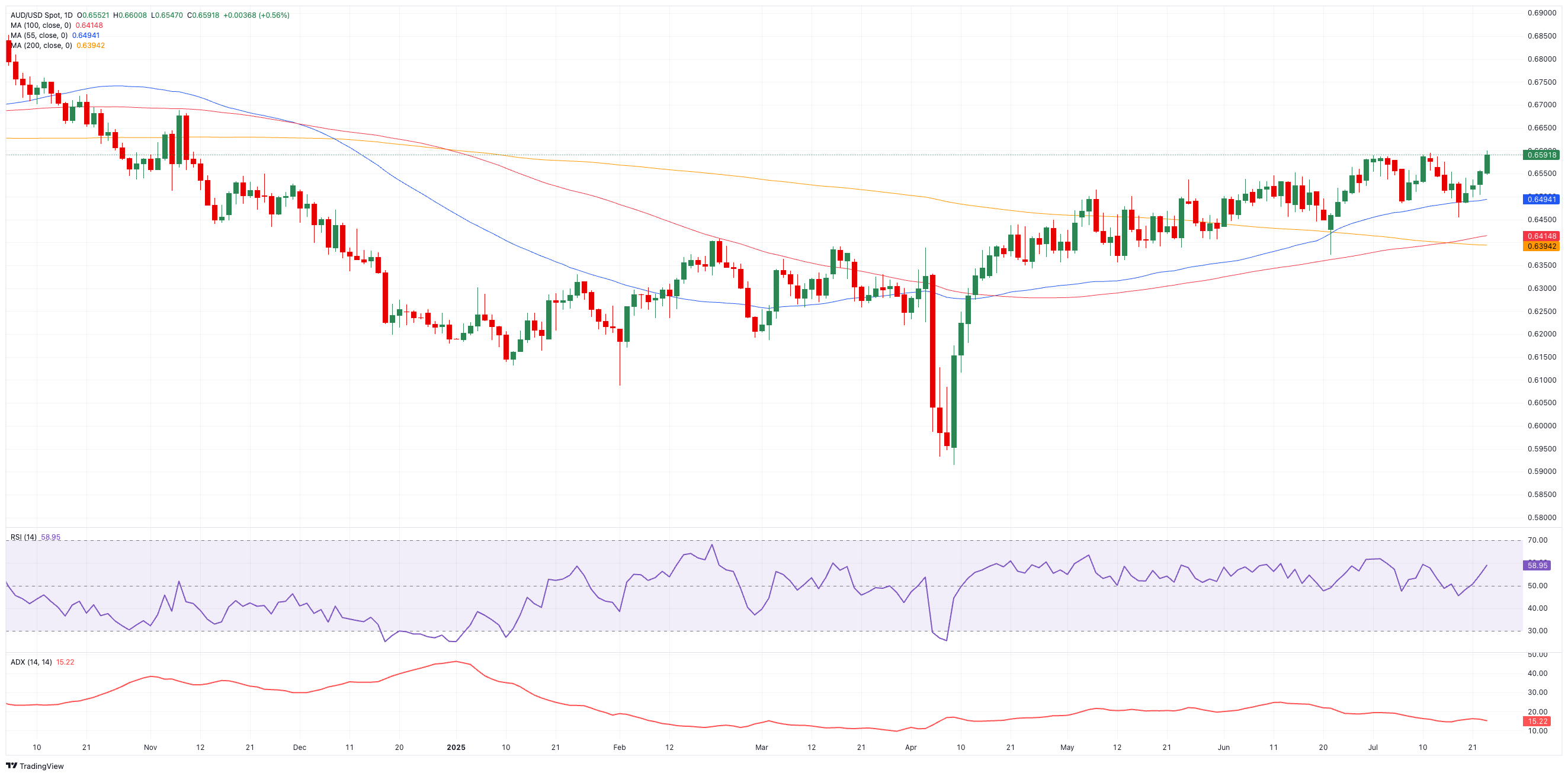
- AUD/USD rose further, finally hitting tops around the 0.6600 barrier on Wednesday.
- The US Dollar gained lacklustre upside momentum as trade jitters subsided.
- Investors will now look at the upcoming preliminary PMIs across the FX space.
The Australian Dollar (AUD) chalked up a fourth straight advance on Wednesday, motivating AUD/USD to finally visit the key resistance area around the 0.6600 hurdle despite humble gains in the US Dollar (USD).
Collaborating with the upside, risk-sensitive currencies, like the Aussie, saw their demand lifted after the United States and Japan clinched a trade deal, announced by President Trump in past hours.
Jobs stumble keeps the narrative alive
A bleak labour‑market print last week did little to slow the bulls. Unemployment ticked up to 4.3%, the economy managed just 2K new positions, and the participation rate inched to 67.1%. Even inflation expectations cooled, slipping to 4.7% in July from 5.0% in June.
That backdrop helps explain why the Reserve Bank of Australia (RBA) surprised earlier this month by holding the cash rate at 3.85% amid a split decision.
Governor Michele Bullock downplayed the split as one of “timing rather than direction,” hinting that a softer Q2 CPI could give the Board cover to deliver its first cut.
Subsequently, Minutes from that meeting echoed that stance: all members agreed underlying inflation is set to drift lower, clearing the way for “some additional reduction in interest rates over time.” A minority argued the downside risks to growth warranted cutting straight away, while the majority felt a third move in four meetings would clash with the “cautious and gradual” mantra.
Futures traders now see the bank easing its policy rate in August, with roughly 75 basis points of easing priced in over the next year.
China’s split‑speed recovery
Australia’s biggest trading partner remains a jumble of signals.
Second‑quarter GDP grew 1.1% (5.2% YoY), and factories are humming at nearly 7% output growth, yet retail spending is stuck below 5% as households squirrel away cash. June’s hefty $114.8 billion trade surplus captures an economy cruising rather than sprinting.
As expected, the PBoC left its one‑ and five‑year Loan Prime Rates (LPR) unmoved at 3.00 % and 3.50 %, respectively.
Policy paths diverge
Both the RBA and the Fed are on pause, but that’s where the similarities end. Washington worries fresh tariffs and a bump in June CPI could reignite US inflation. Any renewed price pressure on either side of the Pacific risks widening the policy gap in a hurry.
Speculators vote with their feet
CFTC data show fast money turning its back on the Aussie: net shorts ballooned to about 75K contracts in the week to 15 July, while total open interest receded to a four‑week low near 150.5K contracts.
Technical picture
Key resistance levels stand at 0.6600—the 2025 peak—seconded by the November 2024 ceiling at 0.6687 (November 7), and ultimately the psychological 0.7000 barrier.
On the downside, support lies at 0.6454, the July floor, with additional backing from the 200‑day SMA at 0.6397, and the June base at 0.6372 (June 23).
Momentum readings show the Relative Strength Index (RSI) hovering near 59 and the Average Directional Index (ADX) below 16, indicating a trend that is losing some traction and still lacks decisive conviction.
AUD/USD daily chart

Bottom line
The Aussie looks penned in by familiar ranges until Beijing fires up a stronger growth pulse or trade tensions supply fresh drama. With the RBA signalling gentle nudges rather than bold shifts, traders will keep hunting for the next catalyst — and for now that means watching China’s data docket and Washington’s inflation chatter.
Australian Dollar FAQs
One of the most significant factors for the Australian Dollar (AUD) is the level of interest rates set by the Reserve Bank of Australia (RBA). Because Australia is a resource-rich country another key driver is the price of its biggest export, Iron Ore. The health of the Chinese economy, its largest trading partner, is a factor, as well as inflation in Australia, its growth rate and Trade Balance. Market sentiment – whether investors are taking on more risky assets (risk-on) or seeking safe-havens (risk-off) – is also a factor, with risk-on positive for AUD.
The Reserve Bank of Australia (RBA) influences the Australian Dollar (AUD) by setting the level of interest rates that Australian banks can lend to each other. This influences the level of interest rates in the economy as a whole. The main goal of the RBA is to maintain a stable inflation rate of 2-3% by adjusting interest rates up or down. Relatively high interest rates compared to other major central banks support the AUD, and the opposite for relatively low. The RBA can also use quantitative easing and tightening to influence credit conditions, with the former AUD-negative and the latter AUD-positive.
China is Australia’s largest trading partner so the health of the Chinese economy is a major influence on the value of the Australian Dollar (AUD). When the Chinese economy is doing well it purchases more raw materials, goods and services from Australia, lifting demand for the AUD, and pushing up its value. The opposite is the case when the Chinese economy is not growing as fast as expected. Positive or negative surprises in Chinese growth data, therefore, often have a direct impact on the Australian Dollar and its pairs.
Iron Ore is Australia’s largest export, accounting for $118 billion a year according to data from 2021, with China as its primary destination. The price of Iron Ore, therefore, can be a driver of the Australian Dollar. Generally, if the price of Iron Ore rises, AUD also goes up, as aggregate demand for the currency increases. The opposite is the case if the price of Iron Ore falls. Higher Iron Ore prices also tend to result in a greater likelihood of a positive Trade Balance for Australia, which is also positive of the AUD.
The Trade Balance, which is the difference between what a country earns from its exports versus what it pays for its imports, is another factor that can influence the value of the Australian Dollar. If Australia produces highly sought after exports, then its currency will gain in value purely from the surplus demand created from foreign buyers seeking to purchase its exports versus what it spends to purchase imports. Therefore, a positive net Trade Balance strengthens the AUD, with the opposite effect if the Trade Balance is negative.
Information on these pages contains forward-looking statements that involve risks and uncertainties. Markets and instruments profiled on this page are for informational purposes only and should not in any way come across as a recommendation to buy or sell in these assets. You should do your own thorough research before making any investment decisions. FXStreet does not in any way guarantee that this information is free from mistakes, errors, or material misstatements. It also does not guarantee that this information is of a timely nature. Investing in Open Markets involves a great deal of risk, including the loss of all or a portion of your investment, as well as emotional distress. All risks, losses and costs associated with investing, including total loss of principal, are your responsibility. The views and opinions expressed in this article are those of the authors and do not necessarily reflect the official policy or position of FXStreet nor its advertisers. The author will not be held responsible for information that is found at the end of links posted on this page.
If not otherwise explicitly mentioned in the body of the article, at the time of writing, the author has no position in any stock mentioned in this article and no business relationship with any company mentioned. The author has not received compensation for writing this article, other than from FXStreet.
FXStreet and the author do not provide personalized recommendations. The author makes no representations as to the accuracy, completeness, or suitability of this information. FXStreet and the author will not be liable for any errors, omissions or any losses, injuries or damages arising from this information and its display or use. Errors and omissions excepted.
The author and FXStreet are not registered investment advisors and nothing in this article is intended to be investment advice.







